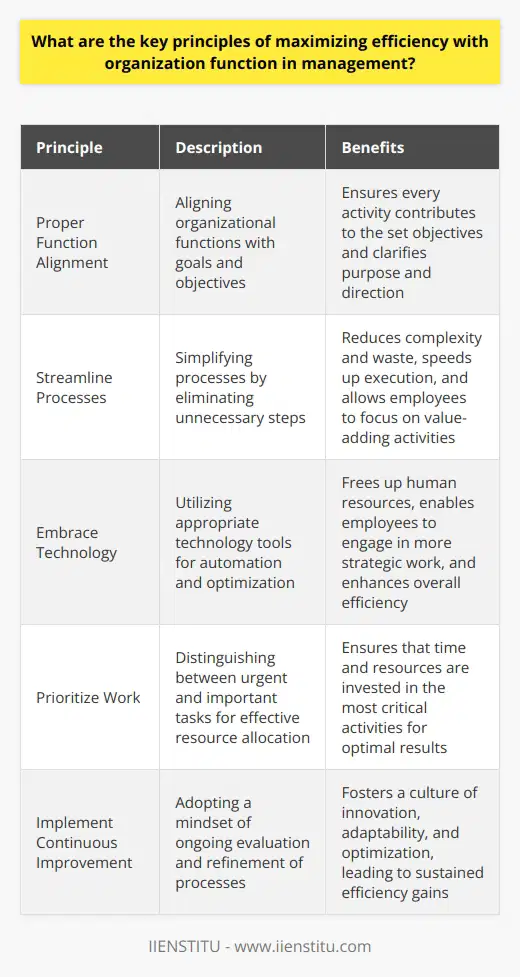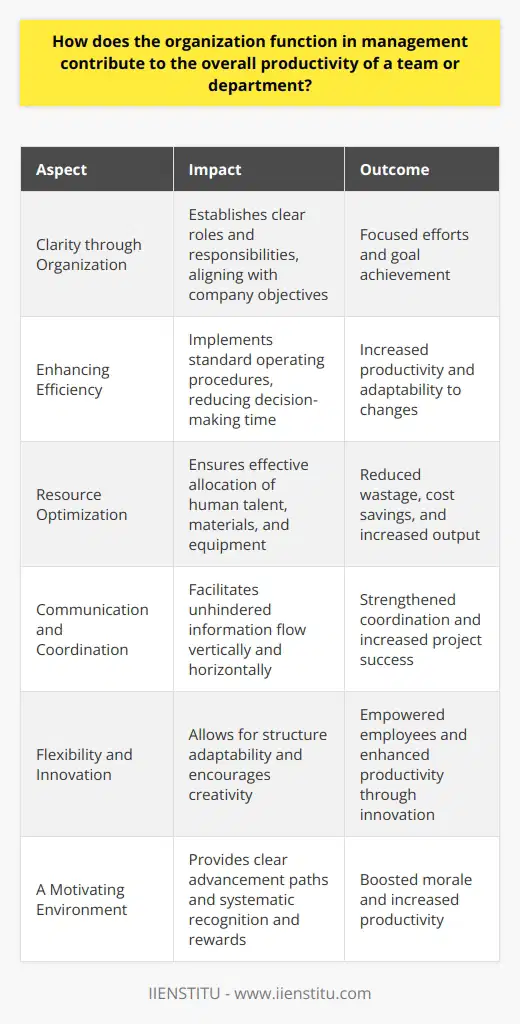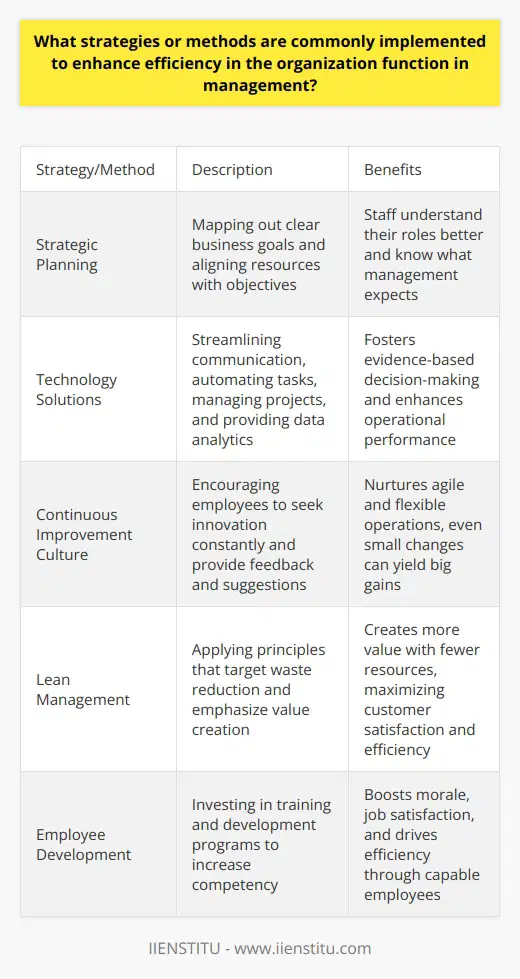
In a business landscape marked by ever-increasing competition and the relentless pursuit of productivity, understanding and optimizing organizational function emerges as a critical lever for management success.
An organization’s ability to maximize efficiency not only affects its bottom line but also defines its potential to innovate, respond to market changes, and deliver value to customers and stakeholders alike. This pivotal role of organization function in management is what we will explore in depth, unveiling the intrinsic ties between deliberate management techniques and overall operational efficiency.
Through examining these key areas, managers can gain insights into structuring their teams and strategies to foster unparalleled organizational success.
Understanding Organization Function in Management
Organization function in the domain of management studies can be understood as the systematic approach to arranging resources—be it human, financial, or informational—to achieve predetermined business goals. This aspect of management is a cornerstone of effectiveness within an establishment; it ensures that each segment of the business operates in harmony with the others, thereby generating a cohesive and streamlined workflow necessary for achieving maximum efficiency.
Key Components of Organizational Structure
The crux of organizational structure lies in elements such as departmentalization, which is the segregation of organizational functions into distinct units or departments. This classification allows for specialization and a focus on expertise, which in turn can drive efficiency and quality of work. The chain of command is another critical element, establishing clear reporting relationships and fostering a sense of accountability within the organization.
Evaluating the span of control—that is, determining the optimal number of subordinates that any one manager can effectively oversee—is also crucial for maintaining a balance between control and autonomy. Finally, organizations must decide on the degree of centralization versus decentralization, with the former potentially leading to more monitored and consistent outcomes and the latter encouraging more innovation and agility.
The Role of Management in Shaping Organizational Function
Leadership and management styles are instrumental in dictating the structure and function of an organization. Authoritative leaders may engineer a rigid organizational structure, while participative managers might espouse flatter and more flexible organizational designs. Management has the responsibility of aligning the structural design of the organization with its culture and strategic goals, thereby influencing the operational pace and approach of the business.
Operational Efficiency Through Management Techniques
Operational efficiency is not an end-state but a continual pursuit that requires strategic management interventions. Efficient operations are characterized by their ability to minimize waste—whether that pertains to time, resources, or effort—and amplify the value generated from business activities.
Strategic Planning and Goal Setting
Strategic planning and goal setting are central to syncing the organizational function with overarching business aims. This alignment is vital for resource optimization, ensuring that each segment of an organization pulls in the same direction. Setting SMART (specific, measurable, achievable, relevant, and time-bound) goals can serve as a compass that guides decision-making and prioritizes actions pertinent to efficiency.
Streamlining Processes for Enhanced Productivity
Process improvement methods such as lean management and Six Sigma focus on eradicating non-value-adding activities and streamlining operational processes. The fusion of these methodologies with modern technology, such as automating repetitive tasks with AI or utilizing data analytics for informed decision-making, constitutes a solid foundation for a productivity surge within an organization.
Communication and Collaboration in the Organizational Framework
Effective communication and collaboration are pivotal in ensuring that all cogs in the organizational machine operate harmoniously. A transparent communication framework eliminates ambiguities, reduces errors, and speeds up information relay—all of which are essential for swift and effective operations. Similarly, nurturing a collaborative environment leverages collective intelligence and capitalizes on diverse strengths, thereby driving efficiency and innovation.
Case Studies and Real-World Application
Academic discourse on organizational function gains tangible value when paired with real-world evidence of successful implementations. By dissecting diverse examples, the distilled insights can be studied, adapted, and implemented by other businesses eyeing similar efficiency gains.
Lessons Learned From Top Performers
Industry titans often set benchmarks for efficiency through their organizational functions. Companies like Toyota with its Toyota Production System have become epitomes of efficiency, showcasing just how transformative a robust organizational structure and culture can be. Examining such cases reveals that commitment to process improvement, an unswerving focus on quality, and a knack for innovation are salient features that can be emulated by aspiring businesses.
Best Practices for Enhancing Efficiency through Organizational Function
Enhancing efficiency is an iterative process that requires constant attention and refinement. Below are some best practices that businesses should consider embedding into their strategies.
Continuous Improvement and Adaptability
Continuous improvement processes such as the Kaizen methodology advocate for regular, incremental changes that collectively result in significant improvements over time. Organizations must also exhibit adaptability, recalibrating their structure and processes in response to internal and external stimuli. This dynamic approach can prevent stagnation and ensure that the business remains competitive and efficient.
Fostering an Efficiency-Centric Organizational Culture
Cultivating an organizational culture that promotes efficiency is equally important. When efficiency is deeply embedded in the corporate ethos, it influences employee behavior and decision-making at every level. This collective mindset not only inspires individual discretionary effort but also ensures that efficiency is a continuous point of focus across the organization.
Throughout this discussion, the imperative of cogent organization function in management for maximizing efficiency has been underscored.
Employing efficacious management techniques within a well-defined organizational structure has shown to be influential in steering a business towards its objectives with economy and agility. Managers are thus encouraged to critically appraise and, if necessary, recalibrate their organizational functions with a view to optimizing operations and staying a step ahead in a dynamic business landscape.
Final Thoughts on Advancing Management Efficiency
In conclusion, the journey towards refining organizational function and management efficiency is unending. As business climates evolve and new challenges arise, so too must the strategies and structures designed to navigate them. By staying attuned to changing trends and maintaining a commitment to efficiency, organizations can ensure sustained prosperity and a lasting competitive edge.
Frequently Asked Questions
What are the key principles of maximizing efficiency with organization function in management?
Maximizing Efficiency in Organizational Functions
Efficiency stands as a cornerstone in management. Managers strive for the optimum use of resources. Thus, organizational efficiency becomes critical.
Understand Proper Function Alignment
Organizations must align functions with goals. This ensures every activity contributes to the set objectives. Managers need to identify and outline core processes. Understanding each function's role clarifies purpose and direction.
Streamline Processes
Processes should be as simple as possible. Unnecessary steps must go. Streamlining reduces complexity and waste. It also speeds up execution. Employees can focus on value-adding activities.
Embrace Technology
Technology drives modern efficiency. Automation of routine tasks is key. It frees up human resources. Employees can then engage in more strategic work. Managers must select appropriate tech tools. These should match the organization's specific needs.
Prioritize Work
Time is finite. Therefore, prioritizing tasks is essential. Managers must distinguish between urgent and important work. This helps in allocating resources effectively.
Foster Communication
Clear communication avoids misunderstandings. It ensures everyone knows their responsibilities. It also enables quick resolution of issues. Information should flow freely but securely.
Encourage Employee Autonomy
Micromanagement hinders efficiency. It stifles creativity and morale. Giving employees autonomy empowers them. It also encourages accountability. Workers can make decisions that speed up processes.
Implement Continuous Improvement
Improvement should be ongoing. Managers must regularly evaluate and refine processes. This means adopting a mindset of kaizen, or continuous improvement. It involves everyone in the organization.
Invest in Training
Skillful employees work efficiently. Managers need to invest in staff training. Training updates skills and knowledge. It also makes adaptation to new processes smoother.
Monitor and Evaluate
Assessment backs up all principles. Managers must monitor performance regularly. They should review both processes and outcomes. This highlights areas for improvement. Data-driven decisions can then optimize efficiency.
Efficiency in organization functions stands non-negotiable. It ensures competitiveness and sustainability. Managers who master these principles pave the way for success.

How does the organization function in management contribute to the overall productivity of a team or department?
The Importance of Organization in Management
Organization stands as a core management function. It acts as a framework within which teams operate. A well-organized structure ensures clear roles. Members understand their responsibilities. Consequently, they avoid overlaps and conflicts.
Clarity through Organization
Organization begins with definitive structuring. It involves creating departments and workgroups. These units must align with the company's objectives. Managers assign tasks to suitable personnel. This process establishes clear accountability. Each member knows their specific job. Clear direction leads to focused efforts. Employees can concentrate on achieving set goals.
Enhancing Efficiency
Efficiency stems from streamlined processes. An organized department implements standard operating procedures. These procedures guide daily activities. They reduce the time for decision-making. Teams can respond rapidly to challenges. Moreover, they adapt quickly to changes. Efficiency naturally increases productivity.
Resource Optimization
An organized management approach optimizes resources. It ensures the best use of human talent. Also, it involves effective allocation of materials and equipment. Wastage reduces. Costs save. The team can do more with less.
Communication and Coordination
Effective organization facilitates communication. Information flows unhindered vertically and horizontally. Managers easily convey strategies. Likewise, team members share updates and feedback. Better communication strengthens coordination. Teams synchronize their efforts. This unity enhances the chances of project success.
Flexibility and Innovation
Organized structures still need flexibility. They must allow room for innovation. Managers can adapt the structure as necessary. They adjust roles and processes to fit new strategies. Flexibility spurs creativity. Employees feel empowered to suggest improvements. Innovation can drive productivity to new heights.
A Motivating Environment
Structure and organization can motivate. Clear advancement paths emerge from organized systems. Employees see career development opportunities. They work harder towards promotion. Recognition and rewards become systematic. Motivation boosts morale. High morale increases productivity.
Management's organizational function is fundamental. It contributes significantly to productivity. It sets the foundation for efficiency and effectiveness. When managers organize well, teams excel. The bottom line benefits from such well-orchestrated team efforts.

What strategies or methods are commonly implemented to enhance efficiency in the organization function in management?
Enhancing Efficiency in Organizational Management
Organizational function within management requires constant attention. Leaders often seek ways to boost efficiency. Efficiency underpins productivity and performance.
Adopt Strategic Planning
Strategic planning sits at the heart of efficiency. It maps out clear business goals. This process aligns resources with objectives. Staff understand their roles better. They know what management expects.
Implement Technology Solutions
Technology holds keys to modern efficiency. It streamlines communication and automates tasks. Software solutions manage projects effectively. They track progress and identify bottlenecks. Data analytics also play a crucial role. They provide insights into operational performance. These insights foster evidence-based decision-making.
Foster a Culture of Continuous Improvement
Organizations thrive on improvement cultures. Employees should seek innovation constantly. Even small changes can yield big gains. Management must encourage feedback and suggestions. This mindset nurtures agile and flexible operations.
Streamline Communication
Effective communication enhances efficiency. Clear instructions prevent misunderstandings. Good communication tools save time. They facilitate collaboration across teams.
Optimize Workflow Processes
Workflows need regular evaluation. Identify steps that add no value. Eliminate such steps. Refine workflows for smooth transitions. Organize workspaces for minimal disruption.
Embrace Lean Management
Lean management principles target waste reduction. They emphasize value creation. Lean techniques create more value with fewer resources. This approach maximizes customer satisfaction and efficiency.
Invest in Employee Development
Capable employees drive efficiency. Investing in training and development is essential. Development programs increase competency. They also boost morale and job satisfaction.
Set Clear Goals and Metrics
Goals and metrics guide operations. They must be specific and measurable. Employees perform better with clear targets. Metrics provide a basis for assessing progress.
Prioritize Time Management
Time is a finite resource. Manage it wisely. Prioritize tasks based on their impact. Discourage multitasking if it hampers quality.
Encourage Delegation
Delegation empowers employees. It also helps managers focus on critical issues. Effective delegation spreads workloads evenly. It builds trust and develops employee skills.
Standardize Best Practices
Standardization ensures consistency. It helps new employees learn faster. Share best practices across the organization. This sharing improves overall efficiency.
To wrap up, enhancing organizational efficiency is multifaceted. It requires a combination of strategic planning, technology adoption, and continuous improvement. Communication, workflow optimization, lean management, employee development, goal-setting, time management, delegation, and standardization all play critical roles. Applying these strategies effectively can transform an organization's performance. Managers must be proactive in identifying and implementing methods to boost efficiency. This commitment drives success and competitiveness in today's dynamic business landscape.



